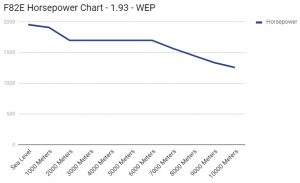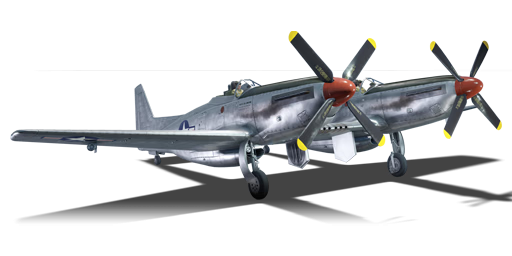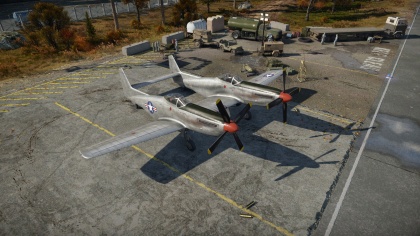F-82E
Contents
| This page is about the American twin-engine fighter F-82E. For other uses, see P-51 (Family). |
Description
The F-82E Twin Mustang is a rank IV American twin-engine fighter
with a battle rating of 5.0 (AB/SB) and 5.3 (RB). This fighter was introduced in Update 1.39.
Perhaps the most distinctive feature about the F-82E "Twin Mustang" is that it literally looks like two P-51 conjoined together into a plane.
This means the F-82E Twin Mustang has nearly two of everything, two fuselages, two engines, two tails, and two pilots. The last of which makes the Twin Mustang more survivable than most other aircraft as each can work independently if the other is incapacitated.
Built with the intent of long-range escort for the B-29 Superfortress bombers, the fuel capacity in the Twin Mustang is also much higher than its contemporaries.
Unlike the preceding American planes, the Twin Mustang no longer features wing-mounted armament but instead are now centre-mounted between the fuselages, so gun convergence is no longer a big issue.
The F-82E works best as a high-altitude bomber-killer or escort plane. While its respectable payload of bombs, machine guns, and rockets make it an effective ground attacker, it is very vulnerable in that role unless the enemy's fighters have all been neutralized.
The F-82E's main assets are its destructive firepower (with the gun pod) combined with massive ammo count, its good climbing speed and its amazing escape speed. Using the tracer bullets and shooting continuously it is possible to adjust aim effectively from more than 1.5 km away. In head-ons, this means your opponent will usually be destroyed or crippled well before he gets his own target indicator. With bombers, it means one serious burst from 0.7-1.0 km will deliver a critical, and a full-second burst from less than 0.7 km should cut any bomber into several pieces.
General info
Flight performance

Describe how the aircraft behaves in the air. Speed, manoeuvrability, acceleration and allowable loads - these are the most important characteristics of the vehicle.
| Characteristics | |||||||
|---|---|---|---|---|---|---|---|
| Stock | |||||||
| Max Speed (km/h at 6,126 m) |
Max altitude (meters) |
Turn time (seconds) |
Rate of climb (meters/second) |
Take-off run (meters) | |||
| AB | RB | AB | RB | AB | RB | ||
| 713 | 696 | 11600 | 28.3 | 28.7 | 15.3 | 15.3 | 450 |
| Upgraded | |||||||
| Max Speed (km/h at 6,126 m) |
Max altitude (meters) | Turn time (seconds) | Rate of climb (meters/second) |
Take-off run (meters) | |||
| AB | RB | AB | RB | AB | RB | ||
| 770 | 742 | 11600 | 25.8 | 27.0 | 26.4 | 18.7 | 450 |
Details
| Features | ||||
|---|---|---|---|---|
| Combat flap | Take-off flap | Landing flap | Air brakes | Arrestor gear |
| ✓ | ✓ | ✓ | X | X |
| Limits | ||||
|---|---|---|---|---|
| Wing-break speed (km/h) |
Gear limit (km/h) |
Combat flap (km/h) |
Max Static G | |
| + | - | |||
| 812 | 450 | 520 | ~8 | ~8 |
| Optimal velocities | |||
|---|---|---|---|
| Ailerons (km/h) |
Rudder (km/h) |
Elevators (km/h) |
Radiator (km/h) |
| < 450 | < 400 | < 500 | > 240 |
| Compressor (RB/SB) | ||
|---|---|---|
| Setting 1 | ||
| Optimal altitude | 100% Engine power | WEP Engine power |
| 5,000 m | 3,200 hp | 4,499 hp |
Survivability and armour
- 38 mm Bulletproof glass - Windshield
- 6.35 mm Steel - Fore cockpit armour plate, pilot and co-pilot
- 8 mm Steel - Armor plate, pilot and co-pilot's seats
- 11 mm Steel - Armor plate headrests, pilot and co-pilot
- 19.05mm Steel - Engine protective plate
Armaments
Offensive armament
The F-82E is armed with:
- 6 x 12.7 mm Browning M3 machine guns, center-mounted (400 rpg = 2,400 total)
Suspended armament
The F-82E can be outfitted with the following ordinance:
- Without load
- 2 x 500 lb AN-M64A1 bombs (1,000 lb total)
- 2 x 1000 lbs AN-M65A1 bombs (2,000 lb total)
- 2 x 2000 lbs AN-M66A2 bombs (4,000 lb total)
- 10 x 127 mm HVAR rockets
- 8 x 12.7 mm Browning M2 machine guns, center-mounted (400 rpg = 3,200 total)
Usage in battles
Start play by climbing above 5,000 m while always maintaining a speed above 290 kph. If this brings you in range of enemy fighters before you have achieved a height advantage simply turn away and let them seek other targets. Once you have achieved 5,000 m altitude with airspeed above 300 kph you are virtually invulnerable since you will always have the option of running away with or without diving. You can seek and destroy bombers. Any fighter foolish enough to go after you should be dealt with head-on starting from more than 1.2 km away to ensure time to adjust and kill with your machine guns. If this is not an option or if you are being engaged by a pair of fighters, or if your initial pass fails to kill, keep running. Very few planes have the ability to follow you and your frame is sturdy enough to withstand the occasional long-distance hit.
As a rule, never let your airspeed drop below 300 kph; do not go near ground level if there is more than one enemy fighter in the vicinity unless your airspeed is above 500 kph, and never engage in furballs.
When used as a heavy fighter, keep in mind the brutally low handling capability of the F-82. Always avoid "furballs" and stay above your opponents. The climb rate makes the F-82 a capable bomber-killer. As a bomber killer, the aiming problems that many pilots face against smaller, more agile fighters evaporate. It is recommended to utilize the 8 x M2 Gun pod, due to the extremely high damage output. However, more experienced players may do away with this option, as it does hamper the handling of the craft.
Due to its high speed, it is very dangerous when used in a boom and run strategy (energy retention and a very high top speed in level flight mean it can be literally untouchable for a lot of single-engine fighters). In this case, it's very important to watch one's speed and to throttle back in dives or it can lose its wings due to high speed. For achieving the maximum straight-line speed at sea level, one should have the engine mixture set to 72%.
Remember, do not attempt to engage smaller and nimbler fighters. Most of the times you will overshoot and completely miss due to the poor handling.
Always use the tracer bullets with your six or fourteen 12.7 mm machine guns. Not only are the tracers very effective incendiaries, but they also give you the ability to see exactly where you are shooting up to 2 km away. This is invaluable in destroying bombers from far enough away to avoid their tail gunners, and in achieving incredible accuracy in head-ons well before your enemy gets a target indicator on you.
Boom and Zoom is not an ideal strategy with the F-82. At about 650 kph you will experience extreme control stiffening. The F-82 excels in the destruction of bombers and other aircraft in head-ons.
Manual Engine Control
| MEC elements | ||||||
|---|---|---|---|---|---|---|
| Mixer | Pitch | Radiator | Supercharger | Turbocharger | ||
| Oil | Water | Type | ||||
| Controllable | Not controllable | Not controllable | Not controllable | Separate | Not controllable | Not controllable |
Modules
| Tier | Flight performance | Survivability | Weaponry | |||
|---|---|---|---|---|---|---|
| I | Fuselage Repair | Radiator | Offensive 12 mm | FMBC mk.1 | ||
| II | New Boosters | Compressor | Airframe | FLBC mk.1 | NAGP mk.1 | |
| III | Wings Repair | Engine | New 12 mm MGs | FLBC mk.3 | ||
| IV | G-Suit | Engine Injection | Cover | FRC mk.5 | ||
Pros and cons
Pros:
- Variety of payload options
- Good fast-firing armament (M3 Browning MGs) with a high ammo capacity
- Above average climb rate
- Fast once upgraded(can outrun pretty much every fighter in level flight)
- Excellent in head-ons (which should rather be avoided due to large profile of F-82)
- M20 API-T ammunition option
- When equipped with a gun pod the F-82 is a flying flamethrower
- Brutal acceleration in dive
- Centre-mounted armament both primary and gun pod, allowing for devastating accuracy
- Pilot and co-pilot seated offset from the centre of the aircraft, making them harder to reliably hit
- Sturdy airframe
Cons:
- Poor handling
- Difficult to aim(it gets a bit better with booster upgrade)
- Elevator prone to failure when damaged
- With the gun pod installed, the continuous fire will slow the plane down significantly
- Prone to control stiffening in a dive
History
Designed to provide the US forces with long-range escort capabilities over the Pacific, the F-82 bore the appearance of desperate measures taken to use surplus P-51 parts. In reality, the F-82 was purposely designed as such in order to provide a fighter plane that had fresh pilots ready to engage, despite the tedious nature of long distance flights. Each fuselage carried a pilot and a co-pilot/navigator which reduced individual fatigue over long missions.
The F-82 started development in 1944, with significant deliveries done in early 1946. Although too late for the war, the fighter still saw extensive use by Air Defense Command as an escort fighter and a night fighter. 14 F-82's were converted to winterized interceptors for use over Alaska. It also saw significant use in the Korean War with Japanese based (US planes deployed from Japan) F-82s among the first aircraft to operate over Korea. In fact, the first three North Korean aircraft shot down by US forces were done so by the Twin Mustang.
In-game description
"In late 1943, North American aviation designers proposed a design project: a new long-range fighter designated the P-82 (NA-120). One two-seat machine was to be created from two P-51D aircraft. The fuselage, one wing (left or right) and the vertical empennage were taken from the production fighter. The fuselages were connected with a new central wing section and a rectangular tailplane. The result was a strong and rigid frame without a central nacelle.
The aircraft was launched into full-scale production in 1944. Several variants were based on it, including the P-82G (NA-150) night interceptor fighter, which started full-scale production in 1946.
The power unit of the P-82G consisted of two Allison V-1710-143 and V-1710-145 (to the left and to the right, respectively) twelve-cylinder, V-type, liquid-cooled engines producing a maximum power of 1,930 hp. The engines were equipped with flame arresters in their exhaust pipes.
An SCR-720C radar was housed in a large container fastened under the center wing section. The radar antenna was installed in a radar-transparent nosecone which protruded ahead of the propeller arc.
The plane's armament consisted of six 12.7 mm Colt-Browning M2.5 machine guns, with 400 rounds each, housed in the center wing section. It was possible to suspend two fuel tanks, two 1,000 lb (454 kg) bombs, or four guide rails for unguided HVAR missiles under the wing panels.
The left cockpit was occupied by the pilot, and the right one by the radar operator. The operator did not have a second control system, so an automatic pilot was installed on the aircraft to reduce the in-flight load on the pilot.
The night interceptor was fitted with extra radio electronic equipment: a blind instrument landing system, a radio altimeter, an AN/APS-13 rear attack warning radar, and an AN/APN-19 identification friend or foe transponder.
In June 1948, the US military aircraft designation system was changed. Accordingly, the P-82G was now designated the F-82G. 14 F-82G fighters were converted to a special F-82H Arctic version, to be operated in Alaska.
Production of the F-82G was discontinued in 1949, with 59 aircraft built in total. They became the last piston-engined fighters built in the USA.
F-82G night fighters participated in the Korean War. On 27 June 1950, the crew of an F-82G from the 68th Fighter Squadron (68 FS) shot down a North Korean plane. It was the first air victory in the Korean War and the first victory of the newly formed USAF."
Media
Excellent additions to the article would be video guides, screenshots from the game, and photos.
See also
Links to the articles on the War Thunder Wiki that you think will be useful for the reader, for example:
- reference to the series of the aircraft;
- links to approximate analogues of other nations and research trees.
External links
| USA twin-engine fighters | |
|---|---|
| P-38 | XP-38G · P-38E · P-38G-1 · P-38J-15 · Bong's P-38J-15 · P-38L-5-LO · P-38K · YP-38 |
| P-61 | P-61A-11 · P-61C-1 |
| F7F | F7F-1 · F7F-3 |
| Other | XF5F · XP-50 · F-82E |





